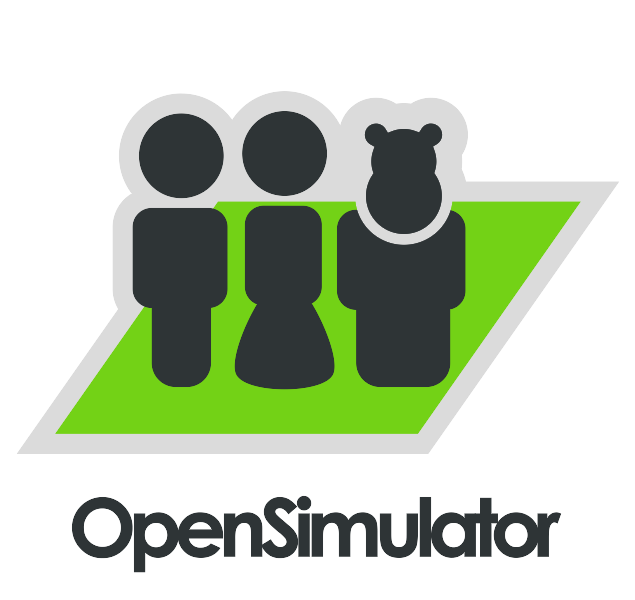Conclusions
The amazing thing about OpenSim is not how many limitations it has, or how awkward some things are, or how frustrating it is not being able to have some as-yet-unimplemented features. No, the amazing thing is that it actually works at all, and, even more important, in terms of a roadmap of features (and system architecture design), how amazing the new features are, which LL hasn’t even dreamed about. Hypergrid allows for distributed UGAIM servers allowing a contiguous grid with many different servers; region splitting and load balancing deal with immediate problems of performance on high-traffic areas and allow, theoretically, lag-free events with thousands of avatars. A modular approach based on plugins, external applications, and web services, allows people now to extend OpenSim’s functionality in several ways and avoid all the silly pitfalls of LL’s own monolithic approach with the long waiting intervals (months) between release dates. To give you an idea, if things in 2009 go as badly as they did with the upgrade to simulation server 1.25 — three months for deployment, and it’s not working yet, the next update will be attempted by the end of January — LL, at most, will be able to release three, perhaps four, versions of the simulation software in 2009. By contrast, you can count on daily releases of OpenSim, and most of them these days are about new features developed by the smallish core team — bugs can be fixed, over time, by the less experient OpenSim developers.
What this means to me is that by the end of 2009, Second Life will have a competitor. It’s called OpenSim — but not one OpenSim grid (ie. not one virtual world), but a complex and intricately interconnected Metaverse, made up of several independently run OpenSim grids, all neatly “hypergrided” between them. Users will just pick one place to log in and create their avatar and leave the inventory there, and happily jump around all over the Hypergrid. Once group functionality is implemented, and vehicles become fully functional, there will be little that OpenSim doesn’t do. Granted, the experience will vary wildly. I can imagine a few OpenSim operators to focus on different aspects. Some, for instance, might just get you super-high-performance UGAIM servers but no regions — for a fee, you’ll have your assets on the best possible hardware, and happily jump across OpenSim grids in search for a place to buy land. Some might focus on the low-end market, giving you cheap servers lightly priced. Others might try to push for high reliability grids, where the cost is pretty much what LL charges you, but allow you to use, say, 20 or 30,000 prims.
Hypergrid also brought the promise of intergrid economy — what this means is that you can use the currency you get in a grid on another one, so long as both providers agree between themselves to exchange currency information. This is quite similar to, say, travelling around the globe and knowing you can exchange your US$ or Euros or pounds sterling by any other currency, and that it happens automatically when you use your card on a local ATM.
So, barring any major catastrophes over the next months, at the end of the year, LL will be in a tight spot: they will be the lone player out of the game.
So, what would I do if I were LL? The answer seems pathetically simple: switch over to OpenSim as well, and drop the internal efforts of maintaining “their own product”, but instead focus on adding value on top of it. In the real world of computer software, this means choosing between the Microsoft way of doing things (“we have our own way of making wheels”) or the Apple way (“let’s get FreeBSD as our OS, paste nice graphics on it, and trademark it as ‘Mac OS X'”).
I suppose this would be gradual. Once OpenSim supports at least the same features as LL’s own simulator software, the first step would be to launch a hypergrided new continent running OpenSim — “inside” LL’s own map — and charge lower prices on that. This would be an option to solve the openspace/homestead dilemma. Give users what they like: cheap, underpowered sims — and keep the “high performance” servers running LL’s own software for high-end customers (e.g. large shops/malls, high-traffic event locations, and so on). With easy teleporting between both, this would just mean that LL would be competing with two lines of products — one for the high-end user, one for the low-end user — and if a lesson can be learned by the openspace/homestead drama, is that people are willing to pay less for lower quality products. Instead of losing all that market to the ever-growing (interconnected) OpenSim providers, be a part of that market. Learn the IBM lesson: you can still sell mainframes and low-end, Linux-based servers.
Best of all, launching a product that has no maintenance costs and no licensing fees, thus being able to be deployed much cheaper, does really not hurt the overall business model (again, that’s the hard lesson that IBM, Dell, HP, or Gateway learned when starting to offer servers with open source, license-free software). It just expands sales, and that is a good thing. It’s not as if LL requires more people to support OpenSim as well. No, in fact, a few of the core developers of OpenSim are LL employees — which means that they would be developing for it anyway, in the interest of LL itself, and they’re already commiting (human) resources to the project. Well, it’s payback time! Let LL launch their own OpenSim grid!
If they don’t, the future in 2010 will look dark for LL, because they have really created a monster that might destroy them. Even if LL continues to insist in “their” Open Grid Protocol, developed at such a slow pace that asset transport between grids will take a decade to be implemented, it’s quite clear that by 2010 all OpenSim-based grids will just use Hypergrid that works today. They might also allow OGP just to get some “visitors” from LL’s own grid, which will just notice how cleverly OpenSim-based grids are already working so well, and create a new account there — leaving LL’s own SL grid. LL tends to insist that the “slow pace of development” is mostly due to security and copyright issues — but I find that just a convenient excuse. First and foremost, as time goes by, it’s quite clear that LL is unable (or unwilling) to prevent content copy on their own grid. Why should they be so worried about content transfer to other grids? I mean, it’s not as if it’s not insanely easy to do it right now, in spite of all LL’s “fears”! On the other hand, the Hypergrid protocol fully addresses ownership and permissions. What it doesn’t do is any “magic” to plug the analogue hole. So, for me, the question is really moot. LL’s focus ought to be how to be part of the interconnected metaverse running OpenSim, and how to be part of it now, way before they figure out that, by 2010, the OpenSim Metaverse has far outgrown LL’s own landmass — and has the same features, the same look and feel, the same people, the same things.
Competing with yourself is always the hardest thing to do. So, no, I don’t think there will be any other “competitor” to SL during 2009. Sony Home might go the same way of Google Lively or not (I think it will), and there are new companies popping up all the time with their own idea of what user-generated content ought to look like. However, that’s really just replacing one company-controlled virtual world with another company — and in my experience, none of those companies will be so “nice” as Linden Lab.
The future is interconnection, and LL has been quite good at promoting that idea. They have always envisioned a metaverse of several interconnected grids, with LL at the core. However, it seems that they have underestimated what this actually means: the interconnected grids using LL’s protocols and looking just like SL are already there and have 30 or 40 thousand users. They will grow to the point where LL is running just one of the many SL-compatible grids, and the only one that is not interconnected, which is absolutely ironic.
I estimate that LL has one or two years to catch up with what they wish to be in the future; after 2010, it’ll be too late. I would urge them to start launching their own OpenSim grid now, abandon OGP in favour of Hypergrid and interconnect their OpenSim grid with other OpenSim grids, and allow all SL-registered avatars to use LL’s UGAIM servers on any other grid interconnected via Hypergrid. And, starting in 2010, enhance OpenSim to replace all sims on their own grid…




